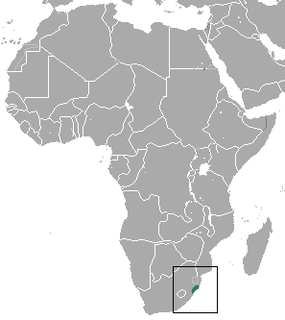
A near-threatened species is a species which has been categorized as "Near Threatened" (NT) by the International Union for Conservation of Nature as that may be vulnerable to endangerment in the near future, but it does not currently qualify for the threatened status.

An IUCN Red List Critically Endangered (CR) species is one that has been categorized by the International Union for Conservation of Nature as facing an extremely high risk of extinction in the wild. As of 2021, of the 120,372 species currently tracked by the IUCN, there are 8,404 species that are considered to be Critically Endangered.

Villa's gray shrew is a shrew native to northeastern Mexico, where it is called musaraña.
Exerodonta abdivita is a species of frogs in the family Hylidae.

Exerodonta catracha is a species of frog in the family Hylidae. It is endemic to Honduras. Its natural habitats are subtropical or tropical moist montane forests, rivers, and freshwater marshes. It is threatened by habitat loss.
Exerodonta chimalapa is a species of frog in the family Hylidae. It is endemic to Mexico. Its natural habitats are temperate forests, subtropical or tropical moist montane forests, and rivers. It is threatened by habitat loss.
Exerodonta melanomma is a species of frog in the family Hylidae. It is endemic to Mexico. Its natural habitats are subtropical or tropical moist montane forests, rivers, and intermittent rivers. It is threatened by habitat loss.
Exerodonta perkinsi is a species of frog in the family Hylidae otherwise known as the Perkins' tree frog. It is endemic to Guatemala. Its natural habitats are subtropical or tropical moist montane forests, rivers, intermittent freshwater marshes, and heavily degraded former forest. It is threatened by habitat loss.
Exerodonta smaragdina is a species of frog in the family Hylidae. It is endemic to Mexico. Its natural habitats are subtropical or tropical dry forests, subtropical or tropical moist montane forests, rivers, freshwater marshes, and intermittent freshwater marshes. It is threatened by habitat loss.
Exerodonta sumichrasti is a species of frog in the family Hylidae. It is endemic to Mexico and known from the Pacific slopes of southern Mexico in the Guerrero, Oaxaca, and Chiapas states as well as from the Chiapan highlands.
Exerodonta xera is a species of frog in the family Hylidae. It is endemic to Mexico. Its natural habitats are subtropical or tropical moist montane forests, subtropical or tropical dry shrubland, and rivers. It is threatened by habitat loss.

The dark-footed mouse shrew is a species of mammal in the family Soricidae found in Mozambique, South Africa, Eswatini, and Zimbabwe. Its natural habitat is subtropical or tropical moist montane forests. It is threatened by habitat loss. It was formerly sometimes called the dark-footed forest shrew.

Sclater's mouse shrew is a species of mammal in the family Soricidae endemic to South Africa. Its natural habitats are subtropical or tropical moist lowland forests and swamps. It is threatened by habitat loss.

Fardoulis's blossom bat is a species of bat in the Pteropodidae family. It is endemic to the Solomon Islands. Its natural habitat is subtropical or tropical moist lowland forests. It is threatened by habitat loss.

The ornate flying fox is a species of flying fox in the family Pteropodidae. It is endemic to New Caledonia. Its natural habitat is subtropical or tropical dry forests. It is threatened due to habitat destruction and hunting, the former exacerbated by high roost-site fidelity.

The Philippine gray flying fox is a species of flying fox in the family Pteropodidae. It is found in Indonesia and the Philippines. Its natural habitat is subtropical or tropical dry forests. It is threatened by habitat loss.

The Comoro rousette is a species of megabat in the family Pteropodidae endemic to the Comoros Islands. Its natural habitats are subtropical or tropical moist lowland forests, caves, plantations, and urban areas. It is threatened by habitat loss.
Helicia shweliensis is a species of plant in the family Proteaceae. It is endemic to China, where it is confined to Yunnan. It is threatened by habitat loss. The causes of habitat loss are attributed to a variety of factors, but the most prevalent factors include the destruction of forests in favor of constructing plantations for the production of cash crops.

Sarcohyla miahuatlanensis, or the Sierra Miahuatlan spikethumb frog, is a species of frog in the family Hylidae. It is endemic to Mexico and only known from its type locality near Candelaria Loxicha on the Sierra de Miahuatlán in Oaxaca.
This page is based on this
Wikipedia article Text is available under the
CC BY-SA 4.0 license; additional terms may apply.
Images, videos and audio are available under their respective licenses.










